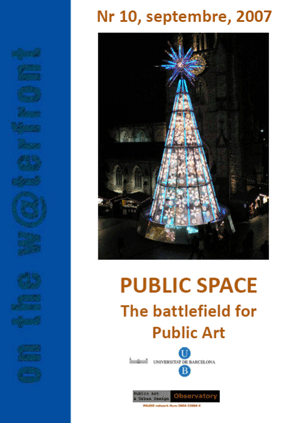THE PLACES FOR PARTICIPATION
Resum
The current upsurge of interest in street art with its direct approach to the city emphasizes the need to readdress public arts’ role within the wider social and cultural context. As it becomes routine to incorporate art works into city planning and city life, art has become both ‘safe’ and ‘user‐friendly’. On the one hand, art is subsumed and immersed into the wider culture through leisure and entertainment policies, socially engaged public art projects, community art and urban design. On the other hand, there are those works which deliberately intend to unsettle or confront the viewer. In recent years the term intervention has been ascribed to unorthodox art works in the public sphere which are often illicit, or at least non‐complicit in the prevailing hegemony. These practices are disruptive due to their enactment outside traditional art spaces, often in the streets. By occupying the streets, places of democracy and disjunction, these interventions transform public space back into a place of overt cultural and political expression. They also deliberately involve the inhabitants of the city by utilizing everyday spaces in ways which offer an unmediated sense of the artwork.Publicades
2007-09-01
Com citar
Carson, Tania. 2007. “THE PLACES FOR PARTICIPATION”. on the w@terfront. Public Art.Urban Design.Civic Participation.Urban Regeneration, no. 10 (September):55-63. https://revistes.ub.edu/index.php/waterfront/article/view/18920.
Número
Secció
Articles
Llicència
 La llicència us permet: Compartir - copiar i redistribuir el material en qualsevol mitjà o format i Adaptar - remesclar, transformar i construir sobre el material per a qualsevol propòsit, fins i tot comercialment. El llicenciador no pot revocar aquestes llibertats mentre l'usuari compleixi els termes de la llicència. Els drets d'autor estan protegits per ISSN 1139-7365. A la revista w@terfront no hi ha restriccions de drets d'autor i permet als autors conservar els drets de publicació sense restriccions.
La llicència us permet: Compartir - copiar i redistribuir el material en qualsevol mitjà o format i Adaptar - remesclar, transformar i construir sobre el material per a qualsevol propòsit, fins i tot comercialment. El llicenciador no pot revocar aquestes llibertats mentre l'usuari compleixi els termes de la llicència. Els drets d'autor estan protegits per ISSN 1139-7365. A la revista w@terfront no hi ha restriccions de drets d'autor i permet als autors conservar els drets de publicació sense restriccions.Aquesta revista no cobra als autors cap taxa per enviar o processar articles.







